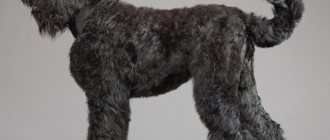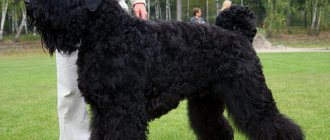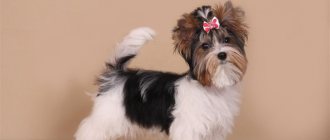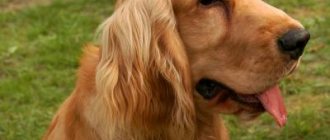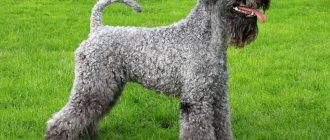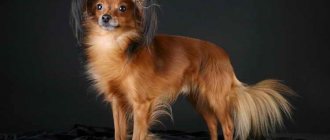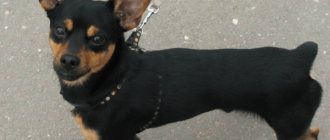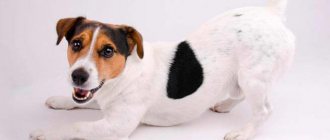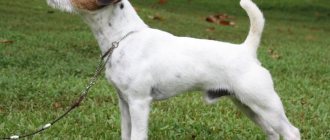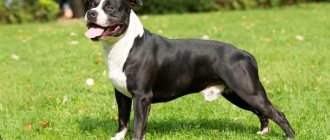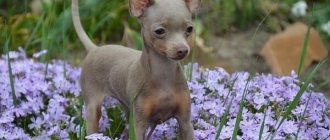History of the Black Russian Terrier breed
Black Russian Terrier
The Black Russian Terrier is one of the few domestic breeds, the breeding of which did not occur spontaneously, but by order of the government. In the mid-40s, the Soviet kennel “Krasnaya Zvezda” was tasked with breeding a type of service dog capable of working productively in extreme weather conditions. The initiator of the experiment was the “father of nations” himself, hence the alternative name – “Stalin’s dog”.
It did not take much time to create the ideal four-legged guard, which cannot be said about the number of animals that took part in the crossing. According to some reports, about 17 breeds donated their genes to Russian Black Terriers, including the Airedale Terrier, Newfoundland, East European Shepherd, Giant Schnauzer, Great Dane and Rottweiler.
Soviet breeders met the first representatives of the black terrier clan already in 1957, at the All-Union Exhibition. A year later, RCT (the abbreviated name of the breed) created its own standard of appearance. In the late 70s, the Blacks began to expand the boundaries of their own popularity, gradually moving to Europe and the American continent. As a result, they were recognized by the FCI in 1983. As for the USA specifically, where the “Red Star” wards made a splash, the first club of breed lovers appeared there back in 1993. But the AKC (American Kennel Club) persisted for another 11 long years, registering black terriers as a separate type of protective guard dog only in 2004.
Similar breeds
Breeds similar to the Black Terrier dog are primarily the breeds that took part in the selection: Newfoundland, Rottweiler, Airedale Terrier and Giant Schnauzer. These dogs resemble “Stalin’s dog” in character and appearance, but differ in care.
Regardless of the purpose of choosing a Black Russian Terrier, this dog will gladly take the place of a faithful companion and devoted friend, but do not forget that in return it will require no less attention, love and care.
Appearance of the Black Russian Terrier
Black Russian Terrier puppy with mom
The Black Russian Terrier is a charismatic, mustachioed athlete, dressed in a glossy black, two-layer “fur coat.” The height of this brutal ranges from 72-76 cm (for males), and the weight can reach 60 kg. Bitches are more graceful than “boys”, but they are also far from babies. The average RCT “girl” weighs from 42 to 50 kg, and this is with a height of 68-72 cm. The breed’s signature features are a long mustache made of wool and shaggy bangs that fall over the eyes, which make the dog look very impressive, if not menacing .
It is worth noting that modern blacks are very different from the RCT of the 50s. The exterior of the animals has become more refined (the fur of the individuals presented at the All-Russian Agricultural Exhibition was noticeably shorter and denser), and their temperament has become more stable. Severe aggressiveness and increased suspiciousness left the breed along with the first generations of dogs, around the 80s. At the same time, from the moment of announcement to this day, work continues to improve the phenotype of the black terrier, since babies periodically “slip through” litters that look very much like their own ancestors, that is, Airedale terriers, Giant Schnauzers and Newfoundlands.
Head
Massive, proportional to the dog’s body. The skull is elongated, of good width, with a flat frontal part. In general, the head of the Black Russian Terrier is not particularly prominent, and the brow ridges, stop, and occipital area of representatives of this breed are not very sharply defined. The muzzle of all RCTs is strong, wide and relatively short.
Teeth and jaws
Curly back of a black terrier
The dog's strong teeth stand close to each other. The jaws are closed in a scissor bite.
Ears
Triangular type, dense, with the leading edge tightly fitting to the dog's head. Ear type – hanging, ear size – medium.
Eyes
Small, widely set, oval shaped. The eyelids of the Black Russian Terrier are black, dry, and fit tightly to the eyeball.
Nose
The lobe is black and large.
Neck
Very dry, but muscular, with a well-defined scruff.
Muzzle of a black Russian terrier
Frame
Representatives of the Black Russian Terrier breed are characterized by a strong, voluminous body with a straight back, complemented by prominent withers and a wide, short loin. The chest of the RCT is deep, elongated oval in shape, with slightly convex ribs. The stomach is slightly tucked and reaches almost to the level of the elbows.
Limbs
All Black Russian Terriers have straight legs, long, noticeably set back shoulder blades, and wide, fleshy hips. The elbows of representatives of this clan are pressed tightly to the body, and the short and massive metacarpus stand at a slight angle. The dog's front paws are noticeably larger than the hind paws and more rounded in shape. At the same time, the pads and claws on both the front and hind limbs have the same color - black.
Tail
Tail of a Black Russian Terrier
Saber-shaped, with a thickened base. In Russia, black Russian terriers usually have their tails docked. At the same time, the natural length of this part of the body is not considered a disadvantage.
Wool
Ideally, a black terrier should have a thick double coat: a hard guard 5 to 15 cm long + a dense undercoat. The dog's muzzle should be richly decorated with wavy hair, forming a lush mustache, a neat beard and shaggy eyebrows.
Color
Everything is simple here: only black color and no more variations. The only exception is a slight gray “patina” on no more than ⅓ of the blackling’s body.
Disadvantages and disqualifying defects of the breed
Flying gait
Minor deviations from the breed standard do not affect show karma, unless their number is too large. But with more serious defects such as a small chest, a squirrel tail, a too short head or light-colored eyes, an animal can at most be classified as “good”, but not “excellent”. If we talk about disqualification, then black Russian terriers who have:
- too obvious similarity with ancestral breeds (Giant Schnauzer, Newfoundland, Airedale Terrier);
- depigmented nose;
- malocclusion;
- eyesore or eyes of different colors;
- white markings on fur;
- straight wool;
- spots of gray “patina” with a distinct outline.
Animals that lack decorative hair on their heads and legs, as well as dogs with too unstable psyches and behavioral disorders, will also not be allowed to exhibit.
Description of the breed with photos
A strong dog with dense bones and developed muscles, the skin fits tightly to the muscular skeleton, there are no folds.
By nature, the black terrier is distrustful and malicious, adapted to every climate zone of Russia and the CIS, and can be trained without problems. Strong or, sometimes, strong-rough constitution. The temperament is balanced, agile, the terrier is capable of reactive self-defense. The breed standard requires:
- The head is moderately wide, the forehead is flat, there is an expressive transition from the forehead to the muzzle.
- Ears are small, high, drooping.
- Eyes are oval, black or brown.
- A scissor bite, in which the upper teeth are in front of the lower teeth.
- Neck – thick, massive, deep chest, convex ribs.
- The tail is thick and docked.
- The front paws are straight, set parallel, the hind paws are set wider.
Size and weight
The average height is 70 centimeters for males and 68 centimeters for females. Males, in comparison with females, are more massive and weigh up to 60 kilograms.
Color and coat type
It is worth saying that the coat of the Black Russian Terrier consists of two components, the main of which is the coat itself, and the additional one is the undercoat. The coat is coarse and thick, the hair is wavy, the length is from five to ten centimeters.
Hair to hair lies tightly, each hair breaks slightly - a feature of wool. The undercoat is compacted and rough. This “double protection” allows Russian terriers to live in the harsh conditions of the northern latitudes of Russia. The hairs form fancy “mustaches” and “beards” and “eyebrows” on the muzzle.
The color is predominantly black, but gray hair, which occupies a third of the coat, is allowed, which is not considered a defect of the breed and is provided for by the standard.
Photo of a black Russian terrier
Features of feeding and diet
The blackie is recommended to eat natural food or balanced dry food. The natural menu should contain lean meat, fish, dairy products, vegetables and fruits in sufficient quantities. The amount of food should be normalized, which will prevent the animal from becoming overweight.
When feeding your Black Russian Terrier dry food, it is important to adhere to the following rules:
- you should choose food according to the weight and age of the dog;
- It is better to feed one type of food and not mix different types;
- Do not mix soft food and dry food;
- The animal must have clean and fresh water in the required quantity.
It is forbidden to give the dog chocolate, sweets, fatty meat, smoked, salty and spicy foods, river fish, and long tubular bones. Such products can disrupt digestion and cause an allergic reaction.
Personality of the Black Russian Terrier
Curious by nature
, the Black Russian Terrier is a bodyguard, a watchman, and a devoted friend at the same time. Despite their professional qualifications, these serious “barbels” relatively quickly adapt to the role of family pets, easily establishing contact even with small children. Suspicion and distrust of strangers - qualities that, by definition, any service breed should have - are manifested in black terriers to a sufficient extent, although not as clearly as in their ancestors who lived in the 50s and 60s. At the same time, they do not start with a half-turn, preferring to once again verify the reality of the threat.
Animals will only risk attacking an enemy when they feel that he is encroaching on the safety of their owner. Moreover, they will never tear the jacket or skin of the aggressor until victory. Their task is to put the attacker to flight, and not to cause him serious injury. The little black one will not greet guests who accidentally look at the light with a dissatisfied grumble (provided that it is raised correctly), but it will also not joyfully jump around them, demanding attention and affection. These shaggy bodyguards have an extremely limited supply of love and tenderness, so the dog prefers to spend it on members of the family in which he lives, but not on casual acquaintances.
Let me hug you!
Russian black terriers diligently guard their master's property. For example, you can leave not only a house, but also an entire estate to these responsible “jocks” without any fear. Rest assured, the animal will not be too lazy to explore every corner of the territory entrusted to it and will not allow a single living soul to enter it. There is an opinion that Russian black terriers have a vindictive and ferocious character. Indeed, the memory of this breed is phenomenal, but this does not mean that its representatives only remember the harm caused to them. The pet will also never forget pleasant moments and the owner’s kindness. By the way, about kindness. In everyday life, RCTs are very proud, which does not prevent them from respecting and sincerely loving their owner. The main thing is not to go too far and not try to train a black terrier to be a bearer of the master's slippers, thereby degrading his working qualities.
In general, today's blackies are quite calm and serious pets who will play with children and happily run after their owner's bicycle. In addition, they are smart enough to understand the owner’s mood by intonation and facial expressions. If the latter is not in good spirits, the Black Russian Terrier will never impose his company on him and will go about his own business. “bearded campaigners” are quite capable of getting along with other dogs. True, only if they do not see them as rivals. Therefore, if you are going to keep two “tails” in your family, then it is best that one of them is a representative of a decorative breed.
Pros and cons of the breed
The modern Russian Terrier is still used as a guard dog and watchman. Only the majority of representatives of the breed perform their duties in families, and not at military or government facilities.
The Black Terrier is a serious, strong dog with a fairly high level of aggression. If you are not sure that you can raise her properly and provide her with the required living conditions, do not rush to buy a puppy. First, familiarize yourself with the main advantages and disadvantages of the breed, then make a decision.
Advantages:
1. Beautiful exterior. 2. Endurance, strength. 3. Devotion. 4. Excellent guard qualities. 5. Gets along great with children. 6. Tolerates both cold and heat normally. 7. Good health.
Training and education
We are listening to you carefully
Service dogs are always a burden of responsibility, especially since others perceive such animals as potential killers and treat them without much sympathy. Take a professional approach to raising your pet or, if this is the first dog in your life, entrust this matter to a specialist. Remember, from a Black Russian Terrier puppy you can mold both a calm children's nanny and a vigilant guard - it all depends on who exactly you want to see in him and what training method you prefer.
The leadership habits of black dogs have not been canceled, so do not trust their training to children or elderly people, in whom the dog sees a “lower caste”. The Russian Black Terrier needs a strict but fair mentor who respects the dignity of the animal, but does not forget about himself. In general, Black Russian Terriers make diligent students, if the peculiarities of their temperament and psychology are taken into account. So, for example, in the case of this breed, multiple repetitions will not work. The animal will follow the command and go through the obstacle course once or twice, after which it will stop any actions. And the point here is not so much in stubbornness, but in the self-esteem of a dog that does not want to play in public. Don't be annoyed if your pet thinks for too long before executing a command. Measure seven times and cut once - this is just about blackies.
Important: Black Russian Terriers can be trained both as puppies and as adults, but in the second case the process will be more difficult. In addition, it is important to immediately choose the right technique, since it will not be possible to correct mistakes made during training. RCTs are not retrained in principle.
Black Russian Terrier watching the surroundings
The youth of the breed should not be discounted. The Black Russian Terrier family is still developing and improving, so among the dogs there may be individuals with completely different learning abilities. For example, animals in which the genes of shepherds and Rottweilers predominate are better suited to the role of bodyguards. Individuals who have inherited the character of Airedale Terriers are more cunning and friendly, so they make ideal companions.
Like most puppies, young blackies are very playful and restless, which is fraught with inevitable destruction in their homes. From the first days of your baby's arrival in the house, curb his violent temper by finding alternative activities for him. For example, buy more rubber squeaks for your puppy, keep him busy with bones and other safe objects.
What not to do
- Abuse the commands “Ugh!”, “No!”, turning your pet’s life into one continuous ban.
- Encourage your puppy to play until he starts biting.
- Play tug-of-war with a baby or teenager whose bite has not yet fully developed.
- It is rude to take away objects that have been damaged by a dog and use physical violence against it.
Black Russian Terrier
Character
The Black Russian Terrier is confident in its abilities in any situation, it is full of dignity, behaves appropriately and calmly. If the situation requires it, when danger or threat arises, the RCT instantly turns into a strict protector, a security guard. He takes an active defensive position, fearlessly ready to repel the attack of any enemy.
The Russian Terrier is intelligent and friendly. He is endlessly devoted to his owner and all family members. Only next to a person is such a dog able to fully develop, both mentally and physically.
Loneliness is unbearable for a terrier. It is impossible to leave such a pet without attention for a long time. A devoted dog can follow its owner all day long, simply enjoying his company.
For children, the black terrier is a faithful friend and play partner. Females show special maternal care to their babies; under such protection the child is safe. Parents must ensure that the dog does not accidentally harm the children with its large dimensions while playing.
Interestingly, representatives of the breed always strive to be closer to the child. If possible, the terrier will even sleep in the children's room, protecting the babies' sleep.
He gets along well with other pets and does not start fights. Conflicts can arise between male dogs.
He treats strangers and house guests coldly, with distrust and hidden aggression. If he notices a threat from them, aggression will immediately manifest itself. The CRT acts instantly, calmly, without warning, and often makes decisions independently. Barks rarely, only in extreme situations.
The Black Russian Terrier requires serious education and training. Without this, he can become an uncontrollable, aggressive and dangerous animal.
Care and maintenance
It’s good if, before buying a black terrier puppy, you managed to acquire a country mansion with a plot of land for a full-fledged walk for your pet. If this does not happen, then you can also experiment with keeping “Stalin’s dog” in a city apartment, but you will have to spend much more effort. Firstly, because Russian RCTs bark quite loudly, which, of course, your housemates will not like. The way out of the problem: seriously engage in training and curbing the “vocal talents” of your pet. Secondly, the Black Russian Terrier is an exclusively working breed, and life is not easy for her without physical activity, so she will have to walk her apartment dwellers more often and for longer.
RCTs living in private houses can be placed in a booth or enclosure, since these shaggy guards are accustomed to low temperatures. But in the autumn-winter period, the dog house will have to be thoroughly insulated. By the way, putting an animal in an enclosure for a day, or even several days, is real barbarity. Even a little blackie living in the yard and having the opportunity to warm up a little still needs a good stretch on the sports ground or in the field.
Hygiene
Black Russian Terrier with his owner
Have you already read on online forums that the breed does not shed? Now forget about it, because in fact, seasonal “hair loss” does occur in Black Russian Terriers. Yes, the RCT’s fur does not shed, but rather falls into tangles, but you still have to take care of it in order to maintain your pet’s spectacular appearance.
Experts recommend brushing your dog every day, and removing matted hair and giving the animal a superficial trim a couple of times a month. However, there are some nuances here too. In particular, among this breed there are both individuals with hard and soft hair, and they are cared for differently. Wire-haired blackies are less problematic in terms of care. Their hair does not fall off and get tangled so actively, so you don’t need to be on duty with a comb and a tangle cutter. For dogs with soft fur, the situation is exactly the opposite: if they are not brushed daily and their tangles are not trimmed in a timely manner, they quickly lose their luster.
A few words about the “bangs” of the black terrier. Ignorant dog lovers often comment on the fact that long hair on an animal’s forehead interferes with its vision. Moreover, according to the same theory, wool gathered in a ponytail is also not a panacea. Allegedly, after such a procedure the dog will certainly go blind. In fact, you can remove your pet's decorative hair any way you want or even braid it. This fact will not affect visual acuity in any way. Nobody forbids leaving the bangs falling over the dog’s eyes either. Believe me, the black terrier will definitely see what he needs through his thick strands.
It is recommended to bathe RCT in cases where the dog’s coat is thoroughly dirty, which often happens with regularly walked dogs. Wash the dog using zoo shampoo, which can be replaced with “human” products for dry and brittle hair, diluted in water. The final stage of washing is applying conditioner or rinsing the wool in a vinegar solution (1 tablespoon of vinegar per liter of water). To prevent your Black Russian Terrier's hair from becoming dry and rough, never blow-dry it or comb it immediately after bathing. Exposing an animal to the sun too often also affects the condition of its coat, so if the dog lives in an enclosure, build a canopy for it for the summer, under which it could hide from the heat.
Black Russian Terrier Grooming
Typically, salon haircuts are given to show-class individuals, but pets can have their fur shortened on their own. To do this, buy hairdressing and thinning scissors, a stainless steel comb and a slicker brush. You can also purchase a special wool machine, which makes cutting faster.
Cropped Black Russian Terrier with docked tail
Do not remove too much hair from the blackie's body, as representatives of this breed love to scratch themselves. The dense undercoat serves as a protective layer that protects the dog’s skin from its own claws, and if it is shortened too much, wounds on the body are inevitable, so the ideal length of hair on the body is 1.5 cm. The same rule applies to the ears, on which it is necessary to leave from 6 to 12 mm wool. If the bangs and mustache of the Black Russian Terrier are shortened, it is only slightly, as this distorts the appearance of the breed. In addition, hair grows very slowly in these areas of the body. It is best to cut only the head, not reaching 2-3 cm from the brow ridges. Between the eyes, you can also cut a regular triangle that goes to the bridge of the nose, which will make your pet’s appearance more advantageous.
On the forelimbs and metatarsals the hair is left longer than on the body. The same is done with the hair on the legs and thighs, which is simply neatly trimmed. But the tufts of hair between the fingers must be carefully cut, since they are the main “garbage collectors”. For hygienic purposes, the abdominal area, groin area and area around the anus are also cut shorter.
Walk
The Black Russian Terrier needs to be walked a lot and productively, this is especially true for apartment dwellers who lack physical activity. Until the puppy has had its first vaccination, walks should be short but frequent. Individuals who have been vaccinated can be taken on longer promenades. The optimal walking time for a one-year-old terrier is 1 hour, and you will have to go outside with the dog at least three times a day. By the age of one and a half years, the blackie can be transferred to a two-time walk.
Since during regular excursions around the city or park your pet will not have time to let off steam, it is better to additionally load it with physical exercises. For example, you can practice agility with your dog or make him run after your bike. It is very useful to create artificial difficulties for the dog. For example, invite her to run on loose, falling snow, or a sandy beach. Such entertainment takes a lot of energy from the animal, while simultaneously training its endurance.
Don’t forget: in places where people are likely to appear, Black Russian Terriers are only walked on a leash and with a muzzle.
Feeding
Black terriers also love autumn photos in the leaves
Black terriers are natural meat eaters. Of course, the dog’s body also successfully breaks down plant proteins, but you are unlikely to be able to turn your blackie into a porridge and carrot lover. Meat should make up at least half, and preferably ⅔, of the animal’s diet, but there are no requirements for its quality. The black terrier will gobble up stringy scraps of horse meat, old beef or a weathered rabbit with the same pleasure as a first-class tenderloin.
To save money, meat can be replaced with offal, which dogs also adore. But you will have to be careful with sea fish, because, for example, excessive consumption of pollock, haddock, blue whiting, whiting and whiting can cause anemia in your pet. It is better to cook porridge from several types of cereals so that the blackie’s body receives all the necessary microelements in one serving. As for pasta and other flour products, it is better not to give them at all, although black terriers will almost sell their souls for them. But as a compromise, a piece of stale or dried rye bread will do. In addition, the black terrier's diet should include seasonal fruits and vegetables (cuts, juices, purees), fresh herbs, low-fat sour milk and eggs.
It is better to feed your four-legged friend from a stand, forming his correct posture. After eating, dogs' whiskers and beard usually become clogged with crumbs, so after each meal, the muzzle must be wiped or even washed. In addition, most blacklings are incredible water drinkers, which is why the hair on their lower jaw constantly gets wet. If you do not pay attention to this factor, then over time a fungus will develop in the beard of the Black Russian Terrier, so if you notice drops falling from your pet’s chin, do not be lazy to blot his face with a towel.
Breed characteristics
| Short description | |
| Origin: | USSR |
| Conditions of detention: | In a house with a large garden |
| Purpose: | Sentry |
| Color: | Black |
| Wool length: | 5-15 cm |
| Adult dog size: | The height of females is 68-72 cm, males 72-76, weight of males is about 50-60 kg, females - 45-50 kg |
| Average life expectancy: | 9-14 years |
| Walk: | Puppies are walked 5 times a day, an adult dog 2 times a day |
| Physical activity needs: | Average physical activity needs (walking 1 to 3 hours per day) |
| Fédération Cynologique Internationale (FIC) classification: | Group No. 2 Pinscher and schnauzer, Molosser, mountain and Swiss cattle dogs; Section No. 1 pinschers and schnauzers |
| Puppy price: | From 10 to 30 thousand rubles.
|
Health and diseases of the Black Russian Terrier
Russian black terriers are practically not susceptible to viral and infectious diseases, and they do not have numerous genetic ailments. But the breed could not avoid dysplasia of the elbow and hip joints, so before buying a puppy, make sure that its parents have successfully passed the test for dysplasia. Otherwise, get ready to stay in veterinary clinics. Of the ailments not related to heredity, the most commonly diagnosed diseases in Russian black terriers are ear inflammation, as well as eye diseases (retinal atrophy, entropy).
Breed standard
The Black Russian Terrier is a large breed of dog. He has a strong, athletic build of a rough type. He has well-developed muscles. Bitches are inferior to males in both height and weight.
The height of adult individuals is 70-78 cm , weight is about 52-60 kg .
On a massive neck rests an equally massive, elongated head. The ears are drooping and triangular.
Dark, oval-shaped eyes, not too large, set wide apart. The eyelids are black, not droopy, dry.
The bridge of the nose is straight, the nose is large with well-opened nostrils. The muzzle is decorated with the lush mustache, beard and eyebrows characteristic of all terriers.
The cheekbones are round. The jaws are powerful. The teeth are large and have a scissor bite.
The physique is powerful and muscular. The back line is straight, the loin is strong. The chest is deep. The ribs are convex.
The tail is thick, saber- or crescent-shaped. Set on high. Cupping is allowed (at the third vertebra).
Legs are straight and parallel. The paws are wide and rounded, which allows the RCT to move freely in the snow. The claws are dark.
The walk is a typical gait, a sweeping trot. Jumps are long, due to the powerful hind limbs.
The coat is thick and hard to the touch. Length is about 6-14 cm. The guard hair is straight, slight waviness is allowed. There is a soft undercoat.
The color is black, with minor inclusions of gray allowed.
How to choose a puppy
What are you watching? Go
If you have decided on a kennel, looked at the puppy’s pedigree and met at least one of its parents, proceed to tests that will help you get some ideas about the character of the future pet. Check your baby's level of contact by sitting him at a distance and beckoning him with your hand. Black Russian Terrier puppies with guard potential will approach a stranger immediately and bark loudly. Kids with the makings of a companion behave more balanced and quiet.
It wouldn't be a bad idea to test the tiny little ones for obedience. Lay the puppy on its side, holding it under the chest, and observe its behavior. The future leader will immediately begin to resist and break free. You can lift your Black Russian Terrier off the ground by holding him by the belly with crossed arms so that he looks into your eyes. The reaction of the future companion and family man to this action will be relatively calm, although a little resistance at the beginning of the procedure is also a good indicator. The dominant will try his best to wriggle out of your hands, simultaneously trying to bite them properly.
Another effective way is to give the puppy a good pat when you first meet him. A child with a stable psyche after such an “execution” will simply shake himself off and move away from you. An unbalanced aggressor, on the contrary, will begin to whine, growl and chew your fingers. And of course, immediately discard overly timid puppies for the simple reason that, like overly angry individuals, they are very difficult to train.
Features of character and behavior
The Black Russian Terrier has a very calm, confident and safe character. He is extremely friendly and outgoing towards his family, but is aloof and distrustful of strangers due to his natural protective instinct. This breed is very good with children and is very trainable. Black Terriers do not suffer from separation anxiety, making them an ideal watchdog.
Black Russian Terriers form strong bonds with their owners and always try to please them. However, for proper training, it is necessary to indicate to the dog who is dominant in the house. This breed is very energetic and is well suited for people with an active lifestyle. In addition, they are well suited for guarding the house and hunting wild animals. At the same time, they do not conflict and do not behave aggressively towards other pets.
Black Russian Terriers are very playful, so they need long walks.
Advantages
The main advantages of this breed include:
- Strong and robust physique;
- Big sizes;
- Harmonious physique;
- Good health;
- Easy to care for;
- Mind;
- Lack of aggression towards children and other pets;
- Wary of strangers;
- Adaptability to heat or cold;
- No seasonal shedding.
Flaws
Along with the advantages, there are also disadvantages, which include:
- The coat requires constant trimming and combing;
- Puppies under 1 year of age require careful and strict training;
- Not suitable for beginners;
- An adult dog needs long and hard training.
Photos of black Russian terrier puppies
Training
The Russian blackie, despite its outward obstinacy, is a very docile animal that is easy to train. They love to learn and perform various tricks. The main thing in this process is regularity and sufficient duration. To maintain success, you need to train with your pet every day.
Note! Experts recommend starting training a puppy from the very moment it enters the family. During the training process, it is necessary to show patience and calmness, give commands in a confident, but not rude tone.
Behavior and temperament
A dog with great dignity, self-confident, well controlled in any situation. If necessary, he immediately takes an active defensive position, but quickly calms down when the danger disappears. RCT is handsome and charming, hardy, unpretentious, smart and friendly. Easily adapts to different climatic conditions, is well trained, efficient, and reliable[2].
The Black Terrier is highly trainable. But it should be borne in mind that this dog is not for sitting on the chain of a private cottage. The black terrier, first of all, requires constant communication with the owner, the family in which he lives.
Diseases and health problems
Black terriers are a breed with good health and natural immunity. These are strong, hardy dogs that can live even in very difficult climatic conditions. However, the puppy's health will largely depend on the health of its parents. For this reason, you cannot buy a dog second-hand without making sure of the good pedigree of his ancestors. If the parents are healthy, then the puppy will grow up strong, beautiful and have a strong immune system.
It is also important to make sure that the puppy does not have any genetic diseases. All genetic diseases in this breed manifest themselves at a very early age. There are illnesses that are easy to keep under control, and there are severe genetic diseases that lead to dog disability and its premature death. Experienced breeders immediately recognize weak offspring and try to get rid of them. If the puppy is healthy, it can live for about eleven years.
Despite their naturally good health, black terriers, like any other dog, are still susceptible to certain diseases. They are often diagnosed with joint dysplasia, otitis media, conjunctivitis, and allergies. It is important to identify all these ailments at an early stage. Then there is a great chance to completely cure your pet. Terriers are also susceptible to ticks, fleas, and worms. You can get rid of them using various sprays, tablets, and shampoos. To prevent the dog from becoming infected again, preventive measures should be carried out approximately twice a quarter. Your pet should be vaccinated against more serious diseases.
Care
Subject to long walks, apartment housing is possible, but it is wiser to keep the pet in a private house, where it is possible to realize the dog’s watchdog instincts.
The wool sheds little; during seasonal shedding, it does not fall off, but rolls into tangles, which will have to be combed regularly, and periodic haircuts will also have to be arranged. They bathe the dog when it gets dirty, using a special shampoo, let it dry naturally, without using a hairdryer, then start combing.
The diet consists of natural products or ready-made dog food.
It is imperative to observe hygiene of the oral cavity, hearing and visual organs of the ward and examine them for the presence of inflammatory signs; if there are problems, immediately contact a veterinarian.
Do not forget about preventive measures against parasites and routine vaccination.
With proper care, the pet's life expectancy will be 12 years or more.
